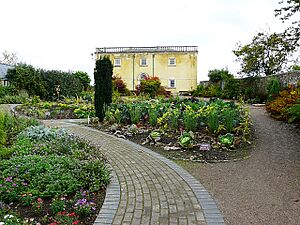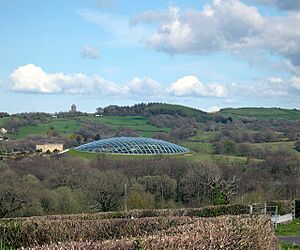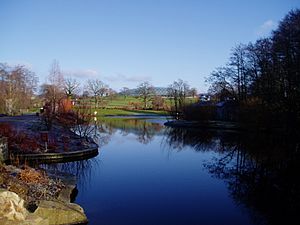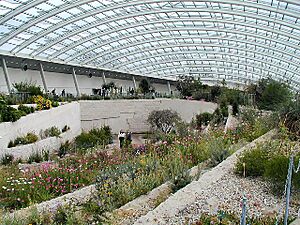National Botanic Garden of Wales facts for kids
The National Botanic Garden of Wales (which is Gardd Fotaneg Genedlaethol Cymru in Welsh) is a special botanical garden found in Llanarthney, Carmarthenshire, Wales. It's located in the beautiful River Tywi valley. This garden is a popular place for visitors, but it's also a very important center for studying and protecting plants. It even has the world's biggest single-span glasshouse, which is about 110 meters (360 feet) long and 60 meters (200 feet) wide!
The garden's main goal is to be a top-notch botanic garden. It focuses on researching and saving different types of biodiversity (all the different kinds of life on Earth). It also aims to help people learn and enjoy nature. The garden is a charity, which means it relies on money from visitors, friends, and special grants to keep going.
Contents
A Look Back: The History of the Site

The land where the garden now stands has a long history. A family called Middleton built a large house here in the early 1600s. Later, in 1789, a wealthy man named Sir William Paxton bought the estate. He spent a lot of money to create an amazing water park.
Sir William hired famous people, like the architect Samuel Pepys Cockerell, to help him. Cockerell designed a brand new Middleton Hall, which was said to be one of the most magnificent houses in South Wales.
Paxton's water park was very clever. Water flowed all around the estate through a system of lakes, ponds, and streams. These were connected by dams, bridges, and waterfalls. Spring water was even stored in high tanks to give Paxton's house running water and fancy water closets (toilets)! This park is now a protected historical site.
In 1806, Paxton also had Paxton's Tower built. This tower is a Neo-Gothic (a style of architecture that looks like old castles) "folly," which means it was built just for decoration. It was made to honor Lord Nelson, a famous British admiral. Today, the National Trust owns this tower.
When Paxton died in 1824, his estate was huge, covering about 2,650 acres (1,070 hectares). It was later sold to different owners. One of them was Edward Abadam, who wasn't very interested in the gardens.
In 1919, the estate changed hands again. Sadly, in 1931, the mansion was completely destroyed by a fire. Only the walls were left standing. After this, the estate fell into disrepair. The walls of the main house were eventually pulled down.
A special tree on the site, known as the Llanarthne oak, almost got cut down during this time. Luckily, it survived! In 2016, it was even named Wales's Tree of the Year.
How the Garden Was Created

In 1978, some local walkers became interested in bringing the old estate back to life. They started raising money, and their efforts led to the discovery of many historical features.
The Great Glasshouse, which is the main building of the garden, now stands almost exactly where Cockerell's mansion used to be. A lot of Paxton's original water features have been brought back to life. The amazing view from the east side of the old mansion, stretching all the way to Paxton's Tower in the distance, has also been restored. Experts say this view helps visitors understand what "picturesque" meant to landscape designers a long time ago.
The garden first opened to the public on May 24, 2000. It was officially opened by Charles, Prince of Wales (who is now King Charles III) on July 21. The architects who designed the Great Glasshouse, Foster and Partners, won a special award for their work. In 2003, the garden faced some money problems, but it received help from the Welsh government and other groups to keep it going.
The garden covers a large area of about 568 acres (2.3 square kilometers). It's home to many rare and endangered plants, like the Sorbus leyana whitebeam tree. The garden also uses modern ideas for recycling and saving energy. For example, they use biomass recycling to heat some buildings, like the visitor center and glasshouses.
Today, most of the garden's income comes from visitors and activities. In 2019, about 160,000 people visited the garden.
Amazing Plant Collections
The Great Glasshouse, designed by Foster and Partners, is the biggest building of its kind in the world. It's about 95 meters (312 feet) long and 55 meters (180 feet) wide, with a roof made of 785 glass panes. Inside, you'll find plants from different parts of the world that have a Mediterranean climate (warm, dry summers and mild, wet winters). These plants come from places like Chile, Western Australia, South Africa, California, the Canary Islands, and the Mediterranean region itself.
The Double Walled Garden has been rebuilt from its old ruins. It's being filled with a wide variety of plants. One part is a modern version of a kitchen garden (where food plants are grown). The other parts show how different flowering plant families are related and how they have changed over time.
In 2007, a new tropical glasshouse was opened. It was designed by a Welsh architect named John Belle. This glasshouse continues to show how plants are classified, focusing on tropical monocotyledons (a type of flowering plant).
In 2015, a large collection of Welsh apple varieties was planted. The garden plans to create a special survey of Welsh apples.
Waun Las National Nature Reserve
The Waun Las national nature reserve is next to the garden. It's a large area of about 150 hectares (370 acres) filled with beautiful wildflower meadows and pastures.
Seen on TV!
The domed greenhouse scenes in the Doctor Who episode The Waters of Mars (from 2009) were filmed inside the Great Glasshouse at the National Botanic Garden of Wales.
See also
 In Spanish: Jardín Botánico Nacional de Gales para niños
In Spanish: Jardín Botánico Nacional de Gales para niños



